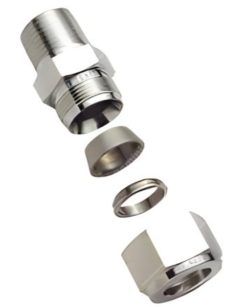When it comes to hydraulic systems, the choice of fittings can make a significant difference in the performance and reliability of the entire setup. Hydraulic fittings serve as the critical components that ensure fluid transfer and connection integrity within hydraulic systems. In this comprehensive guide, we delve into the world of hydraulic fittings, exploring the two primary types and determining the best type for your specific needs.
Types of Hydraulic Fittings
1. Compression Fittings
Double Ferrule Compression Fittings
Compression fittings are a common type of hydraulic fitting known for their simplicity and ease of use. These fittings are typically composed of three main components:
Nut: The nut, often made of brass or stainless steel, threads onto the fitting body and compresses the ferrule onto the tubing, creating a secure seal.
Ferrule: The ferrule, usually made of soft metal like brass, copper, or aluminum, is compressed onto the tubing when the nut is tightened. This compression forms a tight seal that prevents leakage.
Body: The body of the compression fitting houses the tubing and provides the connection point for the nut and ferrule.
Advantages of Compression Fittings:
Simple Installation: Compression fittings are easy to install, making them suitable for applications where quick assembly is essential.
No Welding or Soldering: Unlike some other fitting types, compression fittings do not require welding or soldering, reducing the risk of heat-related damage to the tubing.
Versatility: These fittings can be used with various tubing materials, including copper, plastic, and stainless steel.
2. Flare Fittings
Flare fittings, also known as flared fittings, are another commonly used type of hydraulic fitting. They are particularly well-suited for high-pressure applications. Flare fittings consist of the following components:
Flare Nut: The flare nut is threaded onto the fitting body and creates a tight seal when compressed against the flare on the tubing.
Flare Sleeve: The flare sleeve, also called the ferrule, sits between the nut and the tubing and helps form a secure connection.
Body: The body of the flare fitting provides the housing for the tubing and serves as the connection point for the nut and flare sleeve.
Advantages of Flare Fittings:
High Pressure Capability: Flare fittings excel in high-pressure hydraulic systems, where a strong and leak-free connection is crucial.
Resistance to Vibration: They are less susceptible to loosening due to vibration, making them ideal for applications where machinery movement is a concern.
Durable: Flare fittings are known for their durability and long-lasting performance.
Materials Used in Hydraulic Fittings
Hydraulic fittings can be crafted from several materials, and the choice depends on the specific application and industry requirements. Here’s a detailed look at the most common materials used:
Plastic Hydraulic Fittings:
Advantages: Resistant to corrosion, cost-effective.
Disadvantages: Weaker and less durable than metal fittings.
Application: Limited to low-pressure applications due to their physical weakness.
Steel Hydraulic Fittings:
Advantages: Exceptional durability, capable of withstanding a wide temperature range.
Application: Suitable for high-pressure industrial applications.
Stainless Steel Fittings:
Advantages: Exceptional corrosion resistance, ideal for harsh environments.
Application: Highly corrosive environments and high-pressure applications.
Brass Fittings:
Advantages: Good sealing properties, meets industry standards.
Application: Temperatures ranging from -53°C up to 204°C and pressures up to 3,000 psi.
Aluminum Fittings:
Advantages: Lightweight, corrosion-resistant.
Application: Transportation hydraulics, such as the automotive industry.
Fitting Ends and Connector Types:
O-Ring Face Seal (ORFS): Provides a secure elastomeric seal, ideal for high-pressure hydraulic systems.
DIN or BSP: Commonly used hydraulic fittings in Europe.
Mated Angle: Mechanical seal created by angle seats, suitable for specific applications.
Tapered Threads: Male and female threads deform to create a seal, but prone to shredding and contamination.
What Is the Best Type of Hydraulic Fitting?
The choice between compression fittings and flare fittings depends on the specific requirements of your hydraulic system. Here are some key considerations to help you determine the best type of fitting:
Pressure Rating: If your system operates at high pressures, flare fittings are often the preferred choice due to their robust sealing capabilities.
Ease of Installation: For applications that require quick and straightforward installation, compression fittings are a suitable option.
Tubing Material: Consider the material of your tubing, as different fittings may be more compatible with specific tubing materials.
Vibration and Movement: If your system experiences significant vibration or movement, flare fittings provide added security against loosening.
Last Note
Both compression fittings and flare fittings play vital roles in hydraulic systems. The best type of hydraulic fitting for your application depends on factors such as pressure requirements, ease of installation, tubing material, and the presence of vibration or movement. Understanding the distinctions between these two fitting types will enable you to make an informed decision for your hydraulic system.
Post time: Sep-28-2023


